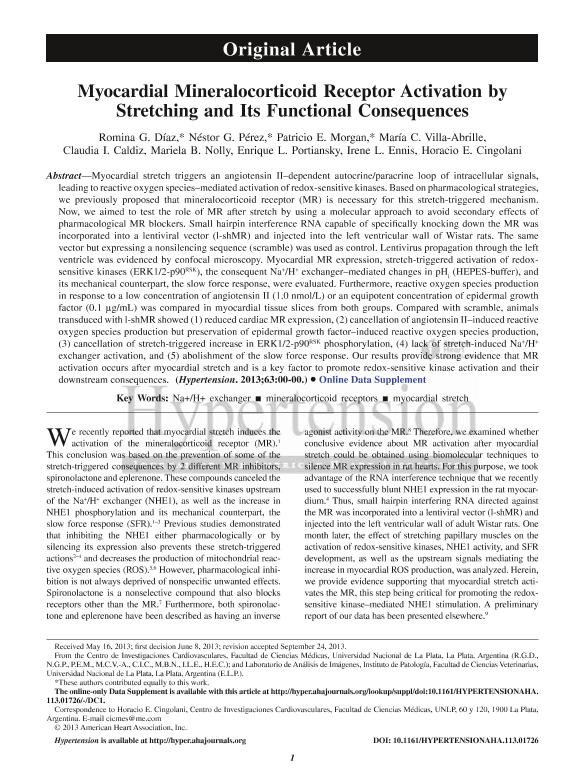Artículo
Myocardial mineralocorticoid receptor activation by stretching and its functional consequences
Diaz, Romina Gisel ; Perez, Nestor Gustavo
; Perez, Nestor Gustavo ; Morgan, Patricio Eduardo
; Morgan, Patricio Eduardo ; Villa-Abrille, María Celeste
; Villa-Abrille, María Celeste ; Caldiz, Claudia Irma
; Caldiz, Claudia Irma ; Nolly, Mariela Beatriz
; Nolly, Mariela Beatriz ; Portiansky, Enrique Leo
; Portiansky, Enrique Leo ; Ennis, Irene Lucia
; Ennis, Irene Lucia ; Cingolani, Horacio Eugenio
; Cingolani, Horacio Eugenio
 ; Perez, Nestor Gustavo
; Perez, Nestor Gustavo ; Morgan, Patricio Eduardo
; Morgan, Patricio Eduardo ; Villa-Abrille, María Celeste
; Villa-Abrille, María Celeste ; Caldiz, Claudia Irma
; Caldiz, Claudia Irma ; Nolly, Mariela Beatriz
; Nolly, Mariela Beatriz ; Portiansky, Enrique Leo
; Portiansky, Enrique Leo ; Ennis, Irene Lucia
; Ennis, Irene Lucia ; Cingolani, Horacio Eugenio
; Cingolani, Horacio Eugenio
Fecha de publicación:
01/2014
Editorial:
Lippincott Williams
Revista:
Hypertension
ISSN:
0194-911X
Idioma:
Inglés
Tipo de recurso:
Artículo publicado
Clasificación temática:
Resumen
Myocardial stretch triggers an angiotensin II-dependent autocrine/paracrine loop of intracellular signals, leading to reactive oxygen species-mediated activation of redox-sensitive kinases. Based on pharmacological strategies, we previously proposed that mineralocorticoid receptor (MR) is necessary for this stretch-triggered mechanism. Now, we aimed to test the role of MR after stretch by using a molecular approach to avoid secondary effects of pharmacological MR blockers. Small hairpin interference RNA capable of specifically knocking down the MR was incorporated into a lentiviral vector (l-shMR) and injected into the left ventricular wall of Wistar rats. The same vector but expressing a nonsilencing sequence (scramble) was used as control. Lentivirus propagation through the left ventricle was evidenced by confocal microscopy. Myocardial MR expression, stretch-triggered activation of redox-sensitive kinases (ERK1/2-p90), the consequent Na/H exchanger-mediated changes in pHi (HEPES-buffer), and its mechanical counterpart, the slow force response, were evaluated. Furthermore, reactive oxygen species production in response to a low concentration of angiotensin II (1.0 nmol/L) or an equipotent concentration of epidermal growth factor (0.1 μg/mL) was compared in myocardial tissue slices from both groups. Compared with scramble, animals transduced with l-shMR showed (1) reduced cardiac MR expression, (2) cancellation of angiotensin II-induced reactive oxygen species production but preservation of epidermal growth factor-induced reactive oxygen species production, (3) cancellation of stretch-triggered increase in ERK1/2-p90 phosphorylation, (4) lack of stretch-induced Na/H exchanger activation, and (5) abolishment of the slow force response. Our results provide strong evidence that MR activation occurs after myocardial stretch and is a key factor to promote redox-sensitive kinase activation and their downstream consequences.
Palabras clave:
MINERALOCORTICOID RECEPTORS
,
MYOCARDIAL STRETCH
,
NA+/H+ EXCHANGER
Archivos asociados
Licencia
Identificadores
Colecciones
Articulos(CCT - LA PLATA)
Articulos de CTRO.CIENTIFICO TECNOL.CONICET - LA PLATA
Articulos de CTRO.CIENTIFICO TECNOL.CONICET - LA PLATA
Articulos(CIC)
Articulos de CENTRO DE INVEST.CARDIOVASCULARES (I)
Articulos de CENTRO DE INVEST.CARDIOVASCULARES (I)
Citación
Diaz, Romina Gisel; Perez, Nestor Gustavo; Morgan, Patricio Eduardo; Villa-Abrille, María Celeste; Caldiz, Claudia Irma; et al.; Myocardial mineralocorticoid receptor activation by stretching and its functional consequences; Lippincott Williams; Hypertension; 63; 1; 1-2014; 112-118
Compartir
Altmétricas



